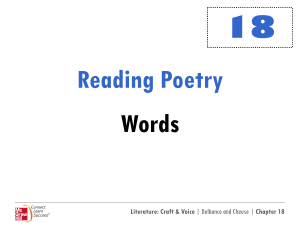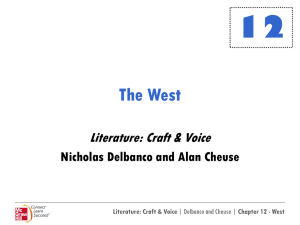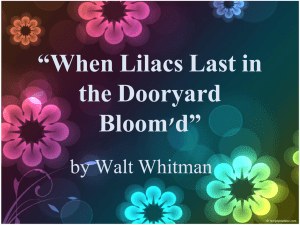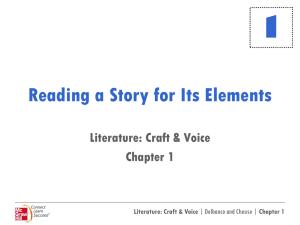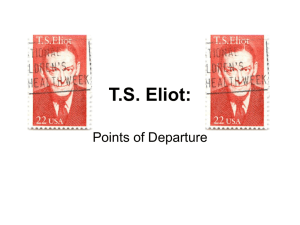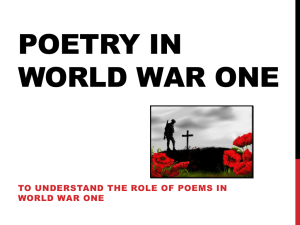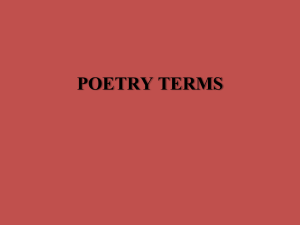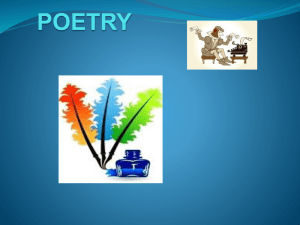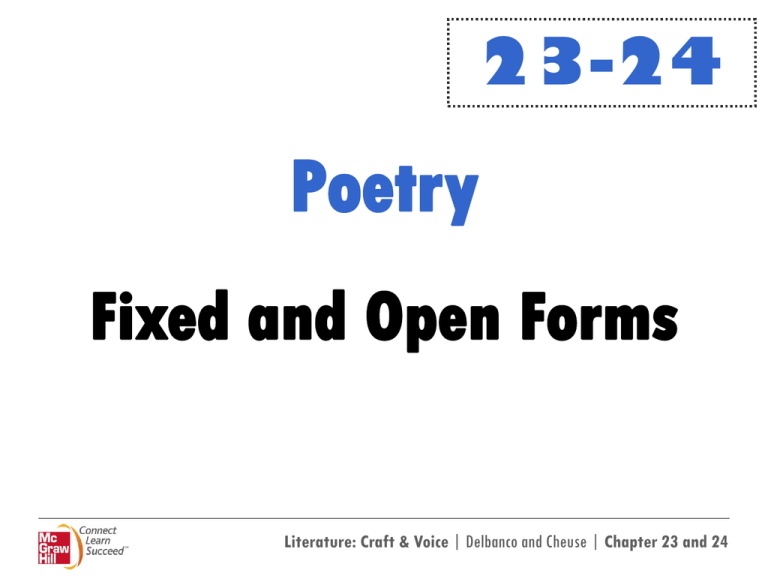
23-24
Poetry
Fixed and Open Forms
Literature: Craft & Voice | Delbanco and Cheuse | Chapter 23 and 24
Poetic Form
• Whether poems are defined as fixed or open, all
poems have form, i.e., an overall shape and
structure. Structures that have long been
established and have been used often will have a
name.
• Fixed forms and open forms refer to the structure
of the poem, not its content or ideas.
Literature: Craft & Voice | Delbanco and Cheuse | Chapter 23 and 24
Fixed Form
•
Fixed forms (sometimes called closed forms) follow a long established pattern of line and
stanza.
•
Fixed forms developed within the oral tradition and made memorization easier.
•
Shakespeare’s plays are written in blank verse (unrhymed iambic pentameter), which
helped the actors remember their lines.
•
Poets converse with past poets through fixed forms, which will inspire not stifle poetic
imaginations. Poets feels challenged to contribute to poetic tradition and be innovative
within a somewhat defined form – although fixed forms are more versatile than
sometimes supposed.
•
Robert Frost could not conceive of writing in free verse. He explained that writing free
verse was "like playing tennis without a net."
Literature: Craft & Voice | Delbanco and Cheuse | Chapter 23 and 24
Fixed Forms continued …
• In Chapter 23 of Literature: Craft and Voice, Nicholas Delbanco and Alan Cheuse
explain poetry’s most popular fixed forms:
• Sonnet
• Sestina
• Haiku
• Limerick
• Ode
• Villanelle
• Pantoum
• Epigram
• Elegy
• We will explore a few of these forms on the following slides.
Literature: Craft & Voice | Delbanco and Cheuse | Chapter 23 and 24
Sonnet
• “A form like the sonnet … exists in poetry not just because
some people like me like to write them. … It must be
serving some kind of function. … Otherwise it would die out.”
– Edward Hirsch
• “A sonnet is a moment's monument,—
Memorial from the Soul's eternity
To one dead deathless hour.”
– Dante Gabriel Rossetti
• “I love sonnets. … I loved them since I first discovered them in middle school,
maybe. I didn’t realize that I loved them because they have a limit. But when
you write a sonnet you discover that having an end in sight forces you into a
kind of compression that I love in art.”
– Molly Peacock
Literature: Craft & Voice | Delbanco and Cheuse | Chapter 23 and 24
Sonnet
•
One of the most enduring and popular forms of poetry has been the sonnet, a fourteen-line poem usually,
but not always, written in iambic pentameter.
•
The sonnet originated in Italian. Sonnetto means “little song.”
•
There are two basic kinds of sonnets: the Italian or Petrarchan and the English or Shakespearean.
Petrarch (1304-1374) was the master of the Italian form, and Shakespeare (1564-1616) the master of the
English form.
•
The Italian form is divided into an octave (eight lines) and a sestet (six lines).
•
The English form is divided into three quatrains (four lines each) and a couplet.
•
The forms are easily recognizable by their rhyme schemes. The Italian sonnet will use a rhyme scheme of
abbaabba in the octave and cdecde or cdcdcd in the sestet – though variations exist, usually there are no
more than 5 rhymes.
•
The English form typically uses abab cdcd efef gg – again, though variations exist, usually there are 7
rhymes.
•
Poets will experiment with these structures. In “The Silken Tent,” for instance, Robert Frost follows a
Shakespearean rhyme scheme, but the structure is more Petrarchan as the poem turns in the ninth line.
Literature: Craft & Voice | Delbanco and Cheuse | Chapter 23 and 24
The Italian Sonnet
•
In Italian or Petrarchan sonnets, the octave commonly introduces a situation, a problem,
a question, or a claim that is resolved, answered, or elucidated in the sestet.
•
There are several Italian sonnets in the text: Wordsworth’s “The World Is Too Much with
Us” and “London, 1802,” Keats’s “On First Looking into Chapman’s Homer,” Browning’s
“How Do I Love Thee? Let Me Count the Ways,” Hopkins’s “God’s Grandeur,” Frost’s
“Design,” and Hacker’s “Elektra on Third Avenue,” among others.
•
In the octave of “God’s Grandeur,” Hopkins celebrates the manifestation of God in the
world but is angry at humankind’s abuse of nature. In the sestet, his anger subsides
and he finds hope through God in nature’s regenerative powers.
•
In the octave of “Design,” Frost describes a natural scene in which a spider is devouring
a white moth on a white flower. In the sestet, he ponders the significance of the event
and the “design” of the world.
Literature: Craft & Voice | Delbanco and Cheuse | Chapter 23 and 24
The English Sonnet
•
In English or Shakespearean sonnets, each quatrain will express a single thought or
emotion, or develop a central idea or problem. The concluding couplet provides the
climax or resolution.
•
There are several sonnets of Shakespeare in the text and several written in the English
form: Keats’s “Bright Star – Would I Were As Steadfast as Thou Art,” Millay’s “Not in a
Silver Casket Cool with Pearl,” Nelson’s “Chopin,” and Molly Peacock’s “Desire,” among
others.
•
In the three quatrains of Shakespeare’s “That Time of Year Thou May’st in Me Behold,”
the speaker bemoans his aging state and compares himself to late fall, the twilight of
the day, and to a fire burning out. However, in the couplet, his self-pity wanes as he
expresses gratefulness to his apostrophized lover.
• In the quatrains of “Desire,” Molly Peacock works out a definition of desire through
metaphor. She brings her definition to a climax in the directness of the couplet, which
privileges desire as “the drive for what is real … the drive to feel.”
Literature: Craft & Voice | Delbanco and Cheuse | Chapter 23 and 24
Villanelle
•
The villanelle evolved from the Middle Ages and simple Italian peasant songs with no
fixed form. The term was adapted by the French, and, in time, strict rules were imposed
on its form. The villanelle made its first appearance in English in the second half of the
nineteenth century and was generally used for lighthearted verse.
•
The villanelle is nineteen lines long (5 tercets and a concluding quatrain) and has only
two rhymes. The first and third lines of the first stanza are rhyming refrains that
alternate as the third line in each successive stanza and end the quatrain.
•
While the form remains consistent, twentieth-century poets have adopted the form for
different kinds of expression other than the light fare of earlier English villanelles.
Consider villanelles like Plath’s “Mad Girl’s Love Song,” Roethke’s “The Waking,” or
Bishop’s “One Art.”
• Many consider Dylan Thomas’s “Do Not Go Gentle into That Good Night” the greatest
villanelle ever composed. Thomas uses the rhyme refrain to create a powerful plea, a
chant, to rally his father to fight for his life.
Literature: Craft & Voice | Delbanco and Cheuse | Chapter 23 and 24
Elegies
•
Today, an elegy is a somber poem, a lamentation memorializing the dead or contemplating
some nuance of life’s melancholy. The expression requires no fixed line or stanzaic form.
•
In ancient Greece, an elegy was defined as a meditation on a serious subject (death, love, or
war) written in dactylic hexameter and iambic pentameter couplets. Elizabethan poets applied
the term to love poems, particularly complaints. It was not until the eighteenth century that
an elegy came to define a poem about death, one usually occasioned by the death of a
particular person.
•
Elegies are generally moving and dramatic personal statements.
•
There are several elegies in the text: Housman’s “To an Athlete Dying Young,” Auden’s
“Funeral Blues” and “In Memory of W. B. Yeats,” Roethke’s “Elegy for Jane,” Osherow’s “Song
for the Music in the Warsaw Ghetto,” Lowell’s “The “Quaker Graveyard,” Hudgins’s “Elegy for
My Father,” and Laux’s “The Shipfltter’s Wife.”
•
The elegy is much more flexible than most fixed forms. Consider how the above elegies use
tone, rhythm, imagery, and other strategies to express grief and to attempt to come to terms
with loss.
Literature: Craft & Voice | Delbanco and Cheuse | Chapter 23 and 24
Elegies
continued …
•
In “Funeral Blues,” an urgent expression of grief, the speaker calls on the world to stop, to
mourn, and to pay tribute to his friend. Now is the time for mourning, the poem proclaims. It
is not yet time to move on.
•
The speaker of “To An Athlete Dying Young” laments the death of his town’s champion athlete.
Using the communal we, the speaker apostrophizes and pays tribute to the still-crowned
champion. He tries to alleviate his own grief by telling the athlete that he may have been
fortunate to have died before he saw his records broken and the joys of his triumph
diminished.
•
Other elegies, like “The Shipfitter’s Wife,” focus on a routine moment to express love and loss.
In the poem, the speaker remembers her husband at the moment when he would arrive home
from work. The tone is tender and more quietly intense than “Funeral Blues,” for instance, as
the speaker’s husband is not so recently deceased. The pain does not seem as raw.
•
In “Song for the Music in the Warsaw Ghetto,” Jacqueline Osherow laments the brutality and
loss of life in the Jewish community during the Nazi occupation. The poem struggles to find a
way to grieve an entire community, for whom music was so inspiring and life sustaining that
they maintained a symphony orchestra while starving and until carried off to concentration
camps.
Literature: Craft & Voice | Delbanco and Cheuse | Chapter 23 and 24
Open Form
•
In the middle of the nineteenth century, poets began to reject fixed forms in favor of forms
that were less rigid, more spontaneous, and free.
•
Open forms (sometimes called "free verse“) do not conform to established patterns of meter,
rhyme, and stanza. Such poetry derives its rhythmic qualities from perhaps the repetition of
words and phrases, sound devices like alliteration and assonance, grammatical structures, the
arrangement of words on the printed page, and many other means. In Al Young’s “Doo Wop:
The Moves,” for instance, the rhythm reflects the music of a doo-wop song.
•
Open-form poets create order and structure in a new way, one which fits the poem. The term
organic is often applied to open-form structures as the structure develops from the content.
Sylvia Plath’s “Metaphor,” for instance, contains nine lines of nine syllables each, reflective of
the length of the human gestation period – which is the topic of the poem.
•
As Cleanth Brooks said, “The parts of a poem are related as are the parts of a growing
plant.”
Literature: Craft & Voice | Delbanco and Cheuse | Chapter 23 and 24
“Poetry without form is a fiction.
But that there is a freedom in
words is the larger fact, and in
poetry, where formal restriction
can bear down heavily, it is
important to remember the cage is
never locked.”
– C. D. Wright
Literature: Craft & Voice | Delbanco and Cheuse | Chapter 23 and 24
“You know, free verse for me … is nothing less
than … a discovery, and we haven’t even got to
the bottom of it yet. We’re only scratching the
surface, because ultimately free verse is a form of
writing in which the poem is completely organized
by instances of coincidence … stanzas are units of
coincidence and lines become units of coincidence,
and the whole poem becomes organized with that
in mind. … It sounds simple, but it’s a lot harder
to do than one would think.”
– Li-Young Lee
Literature: Craft & Voice | Delbanco and Cheuse | Chapter 23 and 24
Walt Whitman
•
Walt Whitman was a leading force in the widespread use of free verse in modern and
contemporary poetry. His volume of poems, Leaves of Grass, first published in 1855, took
imaginative liberties with line length, rhyme, repetition, and diction.
•
No one had ever heard poems quite like Whitman’s before. Most critics and poets did not
appreciate his frank and revolutionary verse. Renowned editor and critic Rufis Griswold
called it “a mass of stupid filth,” and popular poet John Greenleaf Whittier reportedly burned
his copy. One London magazine said that Leaves of Grass proves that the fields of American
literature need weeding, and a London newspaper said Whitman should be publicly flogged.
Emily Dickinson’s father did not allow her to read Whitman, whom he thought indecent and
disgraceful.
•
Of course, not all reviews were negative. The influential literary magazine Putnam’s
considered Leaves of Grass “a mixture of Yankee transcendentalism and New York rowdyism
[which] fuse and combine with the most perfect harmony.” In July 1855, Ralph Waldo
Emerson famously wrote to Whitman: “I give you joy of your free & brave thought. … I find
incomparable things said incomparably well, as they must be. I find the courage of
treatment, which so delights me, and which large perception only can inspire. I greet you at
the beginning of a great career.”
Literature: Craft & Voice | Delbanco and Cheuse | Chapter 23 and 24
Whitman continued …
•
Whitman’s long lines burst forth on the page with boldness and proclamation. His form suggests a large
and expansive voice, one not only reflective of an immodest and daring self but also of an energetic and
resourceful nation. Consider a few lines from “Song of Myself”:
I Celebrate myself, and sing myself,
And what I assume you shall assume,
For every atom belonging to me as good belongs to you. (sec. 1)
Unscrew the locks from the doors!
Unscrew the doors themselves from their jambs!
…
I do not press my fingers across my mouth,
I keep as delicate around the bowels as around the head and heart,
Copulation is no more rank to me than death is.
…
The scent of these arm-pits aroma finer than prayer. (sec. 24)
Do I contradict myself?
Very well then I contradict myself,
(I am large, I contain multitudes.) (sec. 51)
I too am not a bit tamed, I too am untranslatable,
I sound my barbaric yawp over the roofs of the world. (sec. 52)
Literature: Craft & Voice | Delbanco and Cheuse | Chapter 23 and 24
Whitman’s Rhythm
•
The lack of meter and rhyme in Whitman is a major technical innovation. By throwing off the
restrictions of the iamb with its regular rising and falling pattern, Whitman liberated himself and
created a more personal rhythm, something that corresponded with the ebb and flow of his own
emotional vibrancy.
•
Whitman’s diction is often rough and robust. Whitman uses words that previous poets would have
thought ill-befitting the altar of poetry: “barbaric yawp,” “arm-pits,” “bowels,” for example.
While he did not eliminate outworn poetic diction, he did invigorate the old with colloquialisms and
frankness.
•
Each of Whitman’s long, rolling lines is a rhythmic unit and is usually end-stopped. Their long,
flowing rhythms have their source in the King James’ Bible. Compare to Song of Solomon 4:1-7
[“Behold thou art fair, my love”].
•
To create rhythm, Whitman often relies on parallelism, anaphora, alliteration, assonance, and other
poetic devices.
•
Whitman’s cataloging seems tedious to some readers, but this strategy creates not only rhythm but
also a sense of America’s abundant resources. See, for instance, “I Hear American Singing.”
Literature: Craft & Voice | Delbanco and Cheuse | Chapter 23 and 24
Whitman’s Influence
• Whitman’s influence cannot be overstated.
•
As a result of Whitman’s poetics, American poets were emancipated from the iamb and
challenged to define their own poetic rhythms. Because of Whitman, William Carlos
Williams said that American poets who write in iambs have to show cause why it is the
proper form for them.
•
Consider the influence of Whitman on Allen Ginsberg’s “A Supermarket in California”
and Sherman Alexie’s “Defending Walt Whitman.” Note how Whitman has influenced
their poetics and vision of America.
•
Compare and contrast Whitman’s use of open forms with those of others in the text,
particularly Hass’s “Dragonflies Mating,” Cisneros’s “Pumpkin Eater,” Lawrence’s
“Snake,” Stevens’s “Sunday Morning,” and Algarin’s “HIV,” among many others. Is
Whitman’s influence apparent?
Literature: Craft & Voice | Delbanco and Cheuse | Chapter 23 and 24
Visual Poetry
•
The visual appearance of a poem is an often overlooked element of poetry. The neatness of a
sonnet’s appearance, for example, can be very appealing. The poems of Emily Dickinson with their
unorthodox presentation featuring extensive use of the dash and unusual capitalization can be
tantalizing, as can the robust appearance of the long lines of Whitman and Ginsberg.
•
However, visual poetry (sometimes concrete poetry or shaped verse) goes a step further and
organizes lines in a recognizable shape – usually the shape of something the poem describes.
•
Among the visual poems in the text are George Herbert’s “Easter Wings,” John Hollander’s “Swan
and the Shadow,” Chen Li’s “War Symphony,” and Dylan Thomas’s “Vision and Prayer.”
•
Hollander published some 25 shaped poems in his collection Types of Shape. In “Swan and the
Shadow,” he creates the image of the swan and his shadow to suggest the fleetingness of life. The
swan signals his appearance, swims before the speaker, and then disappears. The brief scene,
which unfolds in the same space of time as it takes to read the poem, suggests much about human
consciousness, perception, memory, and contemplation.
Literature: Craft & Voice | Delbanco and Cheuse | Chapter 23 and 24
“Easter Wings”
• “Easter Wings” is probably the most famous visual poem. Shaped like wings,
possibly an angel’s or a bird’s, the poem is a prayer in which the desperate
speaker asks God for salvation.
• The poem is organized into four movements: an emotional reference to the Fall
of Adam and Eve, the speaker’s first request for personal salvation (“O let me
rise”), the speaker’s personal fall, and his second plea for redemption.
• The poem references skylarks and falcons (through imp, which refers to the
reparation of a falcon’s wing or tail). The speaker would like to rise to heaven
in “victory” with the help of Easter wings. For Christians, Easter celebrates
Christ’s resurrection and the acknowledgement that Christ died so that others
could gain salvation.
• Note too that if you turn the poem sideways, its shape resembles a Communion
chalice, which is consistent with a plea for salvation.
Literature: Craft & Voice | Delbanco and Cheuse | Chapter 23 and 24
Visual Poetry continued …
• Consider other less obvious examples of visual poetry in the text: William
Carlos Williams’s “Red Wheelbarrow,” E. E. Cummings’s “Buffalo Bill’s Defunct,”
and “l(a.”
• Note the following complete poem by William Carlos Williams:
ta tuck a
ta tuck a
ta tuck a
ta tuck a
ta tuck a
• Through the arrangement of lines and onomatopoeia, Williams replicates a
stairway and the energetic movement of a bellhop. Sound, rhythm, structure,
and appearance merge for a playful effect.
Literature: Craft & Voice | Delbanco and Cheuse | Chapter 23 and 24
Prose Poems
• Prose poems are usually compact works that look like prose, but
sound and read like poetry.
• Prose poems rely on poetic techniques to create rhythm and
imagery, often to produce a heightened emotional effect.
• Prose poetry was inaugurated in the 19th century in France.
Practitioners included Charles Baudelaire, Arthur Rimbaud, and
Stéphane Mallarmé.
• Whether a short work is a prose poem, a short essay, or a short
story depends entirely on the author’s definition.
Literature: Craft & Voice | Delbanco and Cheuse | Chapter 23 and 24
Prose Poems continued
• Poet William Stafford responded to a question concerning
traditional poetry and the prose poem:
“If it is put in prose form on the page without the line-breaks
then you have given up some of the opportunities that there are
for acrobatic swingings from line to line and emphasizing certain
words or phrases. But you gain something in that the reader will
feel that you are not trying to bamboozle him with white space. Of
course, I like prose myself. Not just prose poems, but prose. So
the prose poems don't worry me. You gain something and lose
something.”
• Is Stafford suggesting that poets try to deceive readers? And that
prose poems are more honest than other poetic forms, including
open forms?
Literature: Craft & Voice | Delbanco and Cheuse | Chapter 23 and 24
“The Colonel” – A Prose Poem
•
•
Carolyn Forché documented human rights violations for Amnesty International. She worked closely
with Monsignor Oscar Romero in El Salvador between 1978 and 1980, during which time she wrote
“The Colonel” – a “documentary poem,” as she calls it.
•
The prose poem derives force from its ominous tone established in the first sentence and its ironic
contrasts throughout. The speaker and her friend eat a sumptuous dinner in a rather commonplace
domestic setting – a daughter files her nails and a cop show plays on television. The mundane
atmosphere contrasts with the violent actions of their host outside the home and the violence
throughout El Salvador.
•
Forché uses the rhythm of simple declarative sentences to create an ominous and eerie tone and to
emphasize the stark brutality of the colonel. … Through the repetition of some, at the end of the
poem, the speaker sounds a voice of resistance, almost a rallying cry.
•
Forché creates an especially jarring contrast through the image of the “green mangoes” and the ears
“like dried peach halves,” which like the television show, indicates how external
violence is infiltrating the home. The ears, in an example of metonymy,
represent the Salvadoran people – those mutilated and murdered by the
death squads and those with ears “pressed to the ground” as they listen and
Through
combination
prose
and poetry, Forché has
resist theabrutal
regime ofofthe
colonel.
created a powerfully disturbing work.
Literature: Craft & Voice | Delbanco and Cheuse | Chapter 23 and 24
For Further Consideration
•
Compare and contrast Housman’s “To an Athlete Dying Young” and Roethke’s “Elegy for
Jane.” Compare the speakers and the imagery. How do they define those they mourn?
How do they express grief? How do they try to come to terms with their grief?
•
Examine how fixed forms operate in the following poems: Kumin’s “Saga,” Bishop’s
“Sestina,” Funkhouser’s “Pantoum of the Great Depression,” Shelley’s “Ode to the West
Wind.” Do they create dramatic effects? Does each form seem especially suitable for the
content of the poem?
•
The following poems might be considered meditations: C. K. Williams “Tar,” Olds’s “Sex
without Love,” Hass’s “Dragonflies Mating,” and Lawrence’s “Snake.” Consider how the
use of an open form reflects the speaker’s contemplative state? Does the form change as
the meditation evolves?
• Compare and contrast the poetic techniques in the prose poems of Louis Jenkins
“Football” and Ray Gonzalez “Corn Face Mesilla.”
Literature: Craft & Voice | Delbanco and Cheuse | Chapter 23 and 24

